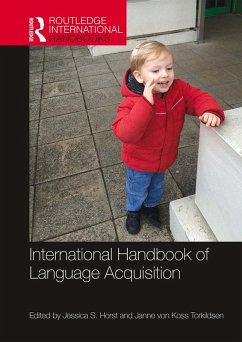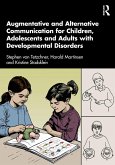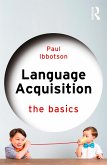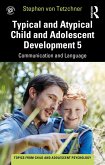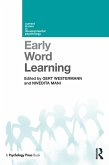International Handbook of Language Acquisition (eBook, PDF)
Redaktion: Horst, Jessica; Koss Torkildsen, Janne von


Alle Infos zum eBook verschenken

International Handbook of Language Acquisition (eBook, PDF)
Redaktion: Horst, Jessica; Koss Torkildsen, Janne von
- Format: PDF
- Merkliste
- Auf die Merkliste
- Bewerten Bewerten
- Teilen
- Produkt teilen
- Produkterinnerung
- Produkterinnerung

Hier können Sie sich einloggen

Bitte loggen Sie sich zunächst in Ihr Kundenkonto ein oder registrieren Sie sich bei bücher.de, um das eBook-Abo tolino select nutzen zu können.
How do children acquire language? How does real life language acquisition differ from results found in controlled environments? And how is modern life challenging established theories? Going far beyond laboratory experiments, the International Handbook of Language Acquisition examines a wide range of topics surrounding language development to shed light on how children acquire language in the real world.
The foremost experts in the field cover a variety of issues, from the underlying cognitive processes and role of language input to development of key language dimensions as well as both…mehr
- Geräte: PC
- mit Kopierschutz
- eBook Hilfe
- Größe: 5.09MB
![Augmentative and Alternative Communication for Children, Adolescents and Adults with Developmental Disorders (eBook, PDF) Augmentative and Alternative Communication for Children, Adolescents and Adults with Developmental Disorders (eBook, PDF)]() Stephen Von TetzchnerAugmentative and Alternative Communication for Children, Adolescents and Adults with Developmental Disorders (eBook, PDF)69,95 €
Stephen Von TetzchnerAugmentative and Alternative Communication for Children, Adolescents and Adults with Developmental Disorders (eBook, PDF)69,95 €![Language Acquisition (eBook, PDF) Language Acquisition (eBook, PDF)]() Paul IbbotsonLanguage Acquisition (eBook, PDF)19,95 €
Paul IbbotsonLanguage Acquisition (eBook, PDF)19,95 €![Abnormal Speech (eBook, PDF) Abnormal Speech (eBook, PDF)]() E. J. BoomeAbnormal Speech (eBook, PDF)52,95 €
E. J. BoomeAbnormal Speech (eBook, PDF)52,95 €![Typical and Atypical Child and Adolescent Development 5 Communication and Language Development (eBook, PDF) Typical and Atypical Child and Adolescent Development 5 Communication and Language Development (eBook, PDF)]() Stephen Von TetzchnerTypical and Atypical Child and Adolescent Development 5 Communication and Language Development (eBook, PDF)18,95 €
Stephen Von TetzchnerTypical and Atypical Child and Adolescent Development 5 Communication and Language Development (eBook, PDF)18,95 €![Early Word Learning (eBook, PDF) Early Word Learning (eBook, PDF)]() Early Word Learning (eBook, PDF)42,95 €
Early Word Learning (eBook, PDF)42,95 €![Speech Recognition in Adverse Conditions (eBook, PDF) Speech Recognition in Adverse Conditions (eBook, PDF)]() Speech Recognition in Adverse Conditions (eBook, PDF)39,95 €
Speech Recognition in Adverse Conditions (eBook, PDF)39,95 €![Communication in Atypical Infants and Toddlers (eBook, PDF) Communication in Atypical Infants and Toddlers (eBook, PDF)]() Christina F. PapaeliouCommunication in Atypical Infants and Toddlers (eBook, PDF)35,95 €
Christina F. PapaeliouCommunication in Atypical Infants and Toddlers (eBook, PDF)35,95 €-
-
-
The foremost experts in the field cover a variety of issues, from the underlying cognitive processes and role of language input to development of key language dimensions as well as both typical and atypical language development. Horst and Torkildsen balance a theoretical foundation with data acquired from applied settings to offer a truly comprehensive reference book with an international outlook.
The International Handbook of Language Acquisition is essential reading for graduate students and researchers in language acquisition across developmental psychology, developmental neuropsychology, linguistics, early childhood education, and communication disorders.
Dieser Download kann aus rechtlichen Gründen nur mit Rechnungsadresse in A, B, BG, CY, CZ, D, DK, EW, E, FIN, F, GR, HR, H, IRL, I, LT, L, LR, M, NL, PL, P, R, S, SLO, SK ausgeliefert werden.
- Produktdetails
- Verlag: Taylor & Francis eBooks
- Seitenzahl: 586
- Erscheinungstermin: 1. Mai 2019
- Englisch
- ISBN-13: 9781351616621
- Artikelnr.: 56845951
- Verlag: Taylor & Francis eBooks
- Seitenzahl: 586
- Erscheinungstermin: 1. Mai 2019
- Englisch
- ISBN-13: 9781351616621
- Artikelnr.: 56845951
- Herstellerkennzeichnung Die Herstellerinformationen sind derzeit nicht verfügbar.
Stanford University
USA Chapter 2: The neural bases of language acquisition Angela Friederici
Max-Planck Institute for Human Cognitive and Brain Sciences
Germany Jens Brauer
Max-Planck Institute for Human Cognitive and Brain Sciences
Germany Chapter 3: The genetics of language acquisition Hayley S. Mountford
Oxford Brookes University
UK Dianne F. Newbury
Oxford Brookes University
UK Chapter 4: Statistical learning approaches to studying language development Ryan A. Cannistraci
University of Tennessee
USA Rodrigo Dal Ben
Federal University of São Carlos
Brazil Ferhat Karaman
University of Tennessee
USA Sara Parvanezadeh Esfahani
University of Tennessee
USA Jessica F. Hay
University of Tennessee
USA Chapter 5: Computational and robotic models of early language development: A review Pierre-Yves Oudeyer
Inria and Ensta ParisTech
France George Kachergis
Stanford University
USA William Schueller
Inria and University of Bordeaux
France Chapter 6: Building the foundations of language: Mechanisms of curiosity-driven learning Katherine E. Twomey
University of Manchester
UK Gert Westermann
Lancaster University
UK Chapter 7: Visual objects as they are encountered by young language learners Hanako Yoshida
University of Houston
USA Caitlin Fausey
University of Oregon
USA Chapter 8: A role for sleep in understanding language acquisition Rebecca Gómez
University of Arizona
USA Katherine Esterline
University of Arizona
USA SECTION 2: Dimensions of Language Learning Chapter 9: Speech perception and discrimination: From sounds to words Caroline Junge
Utrecht University
the Netherlands Natalie Boll-Avetisyan
University of Potsdam
Germany Titia Benders
Macquarie University
Australia Chapter 10: Advances in early speech production: Interactions with maturation
perception and learning Marilyn Vihman
University of York
UK Chapter 11: Learning
recognizing and extending the meanings of words Lynn K. Perry
University of Miami
USA Jessica S. Horst
University of Sussex
UK Chapter 12: Learning language from the use of gestures Katharina J. Rohlfing
University of Paderborn
Germany Chapter 13: Pragmatic development: Learning to use language to communicate Ingrid Lossius Falkum
University of Oslo
Norway Chapter 14: The role of input on syntax and morphology acquisition: Evidence from production Amanda Owen Van Horne
University of Delaware
USA Chapter 15: Learning language is learning typology: Acquisition of argument structure and relative clauses in typologically diverse languages Deniz Özkan
Koç University
Turkey Berna A. Uzundag
Koç University
Turkey Aylin C. Küntay
Koç University
Turkey Chapter 16: Language development in simultaneous bilinguals: The early years Fred Genesee
McGill University
Canada SECTION 3: Individual Differences in Language Development Chapter 17: Individual differences in language acquisition Courtenay Norbury
University College London
UK Chapter 18: Developmental language disorder J. Bruce Tomblin
University of Iowa
USA Chapter 19: Speech sound disorders in children Sharynne McLeod
Charles Stuart University
Australia Sarah Masso
University of Sydney
Australia Chapter 20: Language abilities and language growth in children with hearing loss Teresa Y. C. Ching
National Acoustic Laboratories
Australia Linda Cupples
Macquarie University
Australia Vicky W. Zhang
National Acoustic Laboratories
Australia Chapter 21: Language acquisition in children with autism spectrum disorder Calum Hartley
Lancaster University
UK SECTION 4: Language Development in Everyday Situations Chapter 22: Young children's word learning through overhearing: Next steps Nameera Akhtar University of California
Santa Cruz
USA Jackson Tolins University of California
Santa Cruz
USA Jean E. Fox Tree University of California
Santa Cruz
USA Chapter 23: Learning language in the context of play Catherine S. Tamis-LeMonda
New York University
USA Jacob Schatz
New York University
USA Chapter 24: Learning language from books Elaine Reese
University of Otago
New Zealand Chapter 25: Using digital media to support language learning in early childhood Gabrielle Strouse
University of South Dakota
USA Chapter 26: The co-development of vocabulary and reading comprehension Richard K. Wagner
Florida State University and Florida Center for Reading Research
USA Jamie M. Quinn. Florida State University and Florida Center for Reading Research
USA Chapter 27: The early steps in becoming a writer: Enabling participation in a literate world Rui A. Alves. University of Porto
Portugal Glossary
Stanford University
USA Chapter 2: The neural bases of language acquisition Angela Friederici
Max-Planck Institute for Human Cognitive and Brain Sciences
Germany Jens Brauer
Max-Planck Institute for Human Cognitive and Brain Sciences
Germany Chapter 3: The genetics of language acquisition Hayley S. Mountford
Oxford Brookes University
UK Dianne F. Newbury
Oxford Brookes University
UK Chapter 4: Statistical learning approaches to studying language development Ryan A. Cannistraci
University of Tennessee
USA Rodrigo Dal Ben
Federal University of São Carlos
Brazil Ferhat Karaman
University of Tennessee
USA Sara Parvanezadeh Esfahani
University of Tennessee
USA Jessica F. Hay
University of Tennessee
USA Chapter 5: Computational and robotic models of early language development: A review Pierre-Yves Oudeyer
Inria and Ensta ParisTech
France George Kachergis
Stanford University
USA William Schueller
Inria and University of Bordeaux
France Chapter 6: Building the foundations of language: Mechanisms of curiosity-driven learning Katherine E. Twomey
University of Manchester
UK Gert Westermann
Lancaster University
UK Chapter 7: Visual objects as they are encountered by young language learners Hanako Yoshida
University of Houston
USA Caitlin Fausey
University of Oregon
USA Chapter 8: A role for sleep in understanding language acquisition Rebecca Gómez
University of Arizona
USA Katherine Esterline
University of Arizona
USA SECTION 2: Dimensions of Language Learning Chapter 9: Speech perception and discrimination: From sounds to words Caroline Junge
Utrecht University
the Netherlands Natalie Boll-Avetisyan
University of Potsdam
Germany Titia Benders
Macquarie University
Australia Chapter 10: Advances in early speech production: Interactions with maturation
perception and learning Marilyn Vihman
University of York
UK Chapter 11: Learning
recognizing and extending the meanings of words Lynn K. Perry
University of Miami
USA Jessica S. Horst
University of Sussex
UK Chapter 12: Learning language from the use of gestures Katharina J. Rohlfing
University of Paderborn
Germany Chapter 13: Pragmatic development: Learning to use language to communicate Ingrid Lossius Falkum
University of Oslo
Norway Chapter 14: The role of input on syntax and morphology acquisition: Evidence from production Amanda Owen Van Horne
University of Delaware
USA Chapter 15: Learning language is learning typology: Acquisition of argument structure and relative clauses in typologically diverse languages Deniz Özkan
Koç University
Turkey Berna A. Uzundag
Koç University
Turkey Aylin C. Küntay
Koç University
Turkey Chapter 16: Language development in simultaneous bilinguals: The early years Fred Genesee
McGill University
Canada SECTION 3: Individual Differences in Language Development Chapter 17: Individual differences in language acquisition Courtenay Norbury
University College London
UK Chapter 18: Developmental language disorder J. Bruce Tomblin
University of Iowa
USA Chapter 19: Speech sound disorders in children Sharynne McLeod
Charles Stuart University
Australia Sarah Masso
University of Sydney
Australia Chapter 20: Language abilities and language growth in children with hearing loss Teresa Y. C. Ching
National Acoustic Laboratories
Australia Linda Cupples
Macquarie University
Australia Vicky W. Zhang
National Acoustic Laboratories
Australia Chapter 21: Language acquisition in children with autism spectrum disorder Calum Hartley
Lancaster University
UK SECTION 4: Language Development in Everyday Situations Chapter 22: Young children's word learning through overhearing: Next steps Nameera Akhtar University of California
Santa Cruz
USA Jackson Tolins University of California
Santa Cruz
USA Jean E. Fox Tree University of California
Santa Cruz
USA Chapter 23: Learning language in the context of play Catherine S. Tamis-LeMonda
New York University
USA Jacob Schatz
New York University
USA Chapter 24: Learning language from books Elaine Reese
University of Otago
New Zealand Chapter 25: Using digital media to support language learning in early childhood Gabrielle Strouse
University of South Dakota
USA Chapter 26: The co-development of vocabulary and reading comprehension Richard K. Wagner
Florida State University and Florida Center for Reading Research
USA Jamie M. Quinn. Florida State University and Florida Center for Reading Research
USA Chapter 27: The early steps in becoming a writer: Enabling participation in a literate world Rui A. Alves. University of Porto
Portugal Glossary
